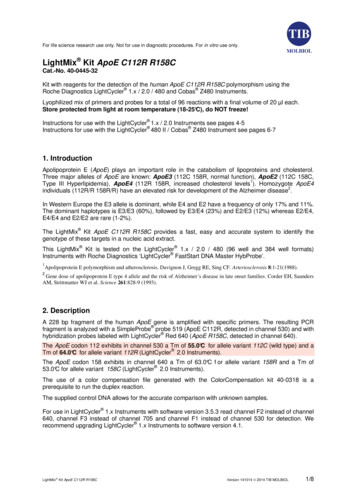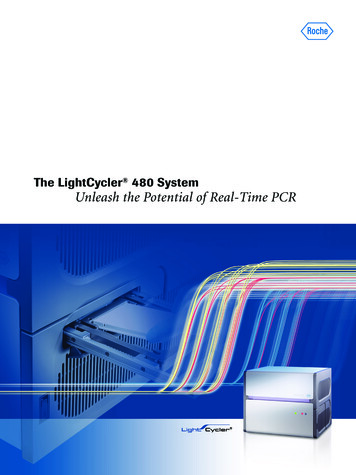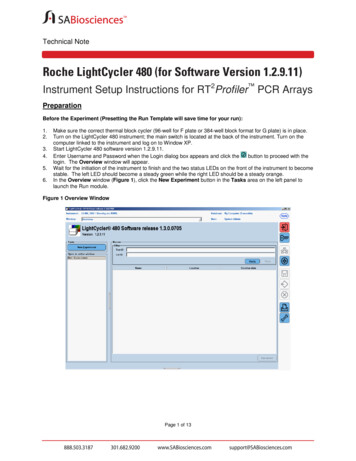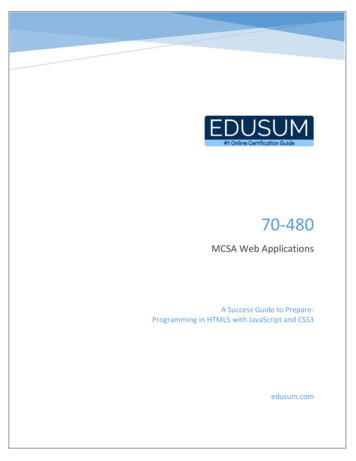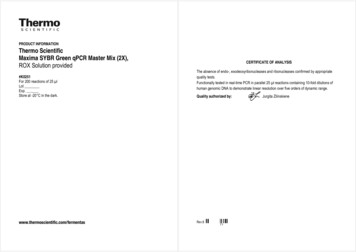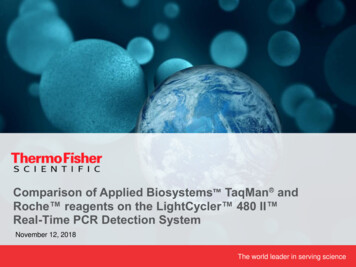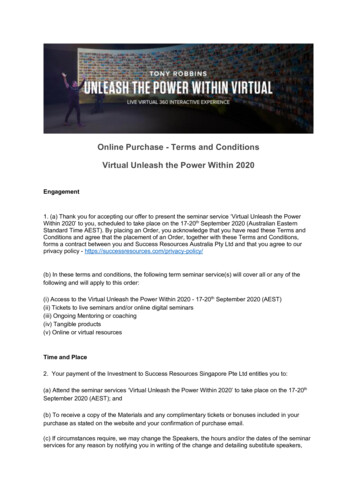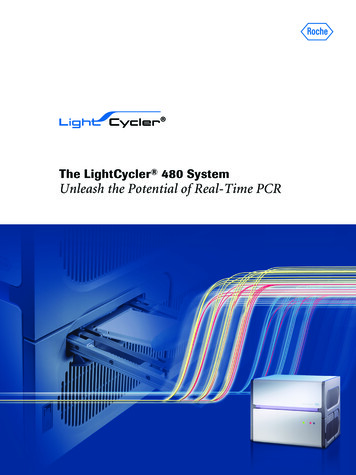
Transcription
The LightCycler 480 SystemUnleash the Potential of Real-Time PCR
Amplify your success in medium- and high-throughput real-time PCRapplications with the renowned LightCycler 480 System fromRoche Applied Science.The LightCycler 480 System is a plate-based, highly adaptable andversatile real-time PCR system for gene expression analysis,SNP genotyping, and mutation scanning via high resolution melting (HRM).The modern instrument design, outstanding technical features, and comprehensive software make the LightCycler 480 System your platform of choice forhigh speed and accuracy in all current real-time PCR applications.The LightCycler 480 Real-Time PCR System3Introduction3System Components5 Instrument Description 5Software 7Reagents and Disposables 8System Applications10Performance Data 10Custom RT-qPCR Assays and Panels 11RealTime ready Cell Lysis Kit 12LightCycler 480 Gene Quantification Solutions 13LightCycler 480 Genotyping Solution 14LightCycler Gene Scanning Solutions 15Automatic Workflow Integration 16The LightCycler 480 Service ConceptLightCycler 480 Instrument SpecificationsOrdering InformationFor life science research only. Not for use in diagnostic procedures.2171819
The LightCycler 480 Real-Time PCR SystemA standard for high-performance real-time PCRTake your real-time PCR projects to outstanding levels of sensitivity, specificity, andthroughput with the accuracy, versatility, and speed of the LightCycler 480 System.Compelling reasons for choosing the LightCycler 480 SystemJ U nique thermal block cycler technology for exceptional well-to-well data homogeneity.J A dvanced optical system for robust and accuratecapturing of all data simultaneously withoutscanning.J E asily interchangeable 96- and 384-wellthermal block cycler units.J O ptional clear or white plates, dependingon your workflow and sensitivity needs.J E xcellent PCR sensitivity with high-valueLightCycler 480 reagents and disposables.J H igh flexibility with fluorescence dyesand detection formats.J B asic and advanced gene expression and geneticvariation analysis.J G enetic variation studies based on HybProbe and/or SimpleProbe Probes, high resolution melting orendpoint genotyping.J Pre-plated, function-tested RealTime ready Assays,available as catalog or custom panels and singleassays.J I ntuitive, user-friendly LightCycler 480Software interface.J Fast and easy assay setup with the newsample editor.J One-click experiment setup with optionsto refine results later.J Multi-function database with research andtraceable modes.J State-of-the-art LIMS connectivity.J 21 CFR part 11 compliant data protection.J Premium customer support and instrumentservice.3
The LightCycler 480 Real-Time PCR SystemProven, high performance technologyFor more than a decade, the LightCycler Real-Time PCR Systems fromRoche Applied Science have stood for flexibility, high speed, and outstandingdata accuracy. The LightCycler 480 System represents the apex of theLightCycler series, offering a comprehensive, high-end qPCR solution forthe modern genomics research lab.Innovative technological enhancements in theLightCycler 480 Instrument pave the way fornew standards of rapid and accurate plate-basedreal-time PCR data generation and analysis. Thesophisticated design of the silver thermal blockcycler unit, calibration-free optical system, andversatile software deliver the sensitivity, accuracy,and reproducibility one has come to expect fromRoche instruments.For enhanced flexibility, many components of theLightCycler 480 Instrument are modular in design.This setup enables users to easily interchangethermal block cyclers (96- and 384-well format),combine various optical filters, and choose betweenclear or white multiwell plates.The system can be seamlessly integrated intocomputer-controlled environments and automatedworkflows. This system setup facilitates datamanagement that complies with 21 CFR Part 11requirements.The LightCycler 480 System comprises versatileinstrumentation and software as well as highperformance reagents, customized qPCR assays(see p. 11) and specially engineered disposableproducts. This innovative system meets the toughdemands of qualitative target detection, quantitativegene expression, and mutation analysis. In addition,its built-in versatility facilitates easy adaptation tonew technologies in genomic research.silver multiwell plate mountcircuit board(Peltier elements)Therma-Base layercooling elementFigure 1: Flexibility of the LightCycler 480 Block Cyclerunit. The LightCycler 480 Block Cycler units (96-well/ 384-wellformat) are easily interchangeable by the user, taking only afew minutes. The exchanged block cycler unit is automaticallydetected and identified by the system, and experiments canproceed without time-consuming recalibration runs.4Figure 2: Schematic of the LightCycler 480 Thermal BlockCycler. The Therma-Base layer, implemented in the block cyclerunit architecture, is a thin cavity lined with a wick structure andfilled with fluid. Utilizing a series of condensation and evaporationevents, the Therma-Base rapidly adjusts to temperature changesby efficiently dissipating heat.
The LightCycler 480 InstrumentA superb combination of speed, accuracy, and versatilityInnovative PCR thermal block cycler designThe LightCycler 480 System has revolutionizedblock cycler temperature control through theintroduction of a highly efficient heat-equalizingtechnology (Therma-Base) between the heatblock and the cooling element. By removing theeffects of spreading resistance, the LightCycler 480 thermal block cycler provides outstandingwell-to-well temperature homogeneity (see Figures3 and 4). The precise temperature control enablesexceptional data uni formity, independent of assayformats or real-time PCR applications, even in fastPCR protocols.Key benefits of the LightCycler 480 ThermalBlock Cycler:J R un any assay format or application with fastPCR protocols ( 40 minutes for 40 cycles in384-well plate format).J O btain rapid and accurate temperatureadjustment.J A chieve exceptional data homogeneity acrossthe entire multiwell plate.TmTm110,50,500-0,5-0,511591317Columnsa21 PAFK-1Rows91317FK21 PAacross a multiwell plate (at 50 C). The variation between themeasured Tm, and the expected Tm of the oligonucleotide wasplotted for all 384 wells using the expected Tm as zero.CqCqa3Scale: 0.5Scale: 0.51157Columns911ACE-1RowsColumnsbFigure 3: Temperature homogeneity across a 384-well plate:a) LightCycler 480 Instrument; b) another real-time PCRinstrument. The melting temperature (Tm) of a given labeledoligonucleotide was used to demonstrate temperature homogeneity5GRowsFigure 4: Crossing point (Cq) homogeneity across a 96-wellplate: a) LightCycler 480 Instrument; (b) another real-timePCR instrument. A low target concentration (100 copies) of ab357Columns911ACEGRowsgiven target sequence (442 bp) was amplified using a fast PCRprotocol (20 µl reaction volume, hydrolysis probe format). Cq valueswere plotted for all 96 wells using a 0.5-step C q scale resolution.5
The LightCycler 480 InstrumentAn ideal combination of speed, accuracy, and versatilityexcitation filter wheelAdvanced high-performance optical systememission filter wheelThe LightCycler 480 Instrument’s optical systemfeatures a high-intensity LED which emits light acrossa broad spectrum. A flexible combination of built-infilters for specific excitation and emission facilitatesthe use of a variety of fluorescent dyes and detectionformats for any current real-time PCR application(see Table 1).The special arrangement of the optical componentsand the optimum focal length in the LightCycler 480Instrument ensure excellent specific signal excitationand uniform data capturing across the entire multiwellplate, independent of sample position. Together withexcellent signal acquisition rates, this also allowsmelting curve analysis at high resolution. It alsoeliminates the need for passive reference dyes (e.g.,ROX) for well-to-well signal normalization. As aresult, the LightCycler 480 System gives you theadded flexibility to use all channels for targetdetection, extending multiplexing capabilities.Table 1: Overview of excitation and emission filters, dyes anddetection formats. The LightCycler 480 Instrument employs ahigh-intensity LED that emits light over a broad wavelength range(390–710 nm). The five excitation and six emission filters of theinstrument can be used in any combination.*FRET Donor6CCD cameraoptical pathfield lensPCR multiwell plateFigure 5: Schematic of the LightCycler 480 Detection Unit.Key benefits of the LightCycler 480 OpticalSystem:J Capture all data simultaneously for a wholeplate without the need to scan, avoidinginconsistencies and mechanical instability.J Enjoy highest flexibility in the choiceof fluorescence dyes and detection formats.J Get advanced accurate data capture acrossthe entire plate without fluorescence signalnormalization.J Work with enhanced multiplexingcapabilities. J Easily access commonly used channelcombinations via pre-defined settings. See for example: Richard Molenkamp et al., (2007). Journal of VirologicalMethods, Volume 141, Issue 2, Pages 205-211.
The LightCycler 480 SoftwareAdvanced tools to generate high quality dataHigh-value software capabilitiesThe LightCycler 480 Software is characterized bystate-of-the-art design and unique algorithmsfor fast, highly accurate data generation, withoutsacrificing comprehensive versatility. Customizableviews facilitate intuitive navigation, and a highlysophisticated sample editor allows easy programming,data capturing, and analysis. Convenient import andexport functionalities enable the seamless integrationof the LightCycler 480 Instrument into computercontrolled environments. Additionally, modern datamanagement and effective data protection capabilitiesare implemented in the software.The LightCycler 480 Software provides versatilesolutions for the most common real-time PCRapplications. The pre-installed software packagecomprises automated analysis modules for meltingcurve or endpoint-based genotyping as well asabsolute and relative quantification. Additionalsoftware modules are available for high resolutionmelting and multiple plate analysis.Thus, the LightCycler 480 System meets all yourresearch needs, from comprehensive customizedscientific approaches to streamlined automatedroutine workflows.Key benefits of the LightCycler 480 Software:J Quickly start experiments from ready-to-usemacros or templates for all applications.J Apply basic or advanced analysis modes forboth gene expression and genotyping studies.J Conveniently define or edit sampleinformation in plate or table views.J Choose between a flexible research modeor a secured traceable database mode.J Benefit from high-end reporting tools togenerate separate documentation for eachanalysis.Figure 6: Screenshot ofthe LightCycler 480Software interface(opening screen): Gain easy accessto a broad range ofquantification andgenotyping methods. Quickly start newexperiments from macrosor templates.7
LightCycler 480 Reagents and DisposablesMaximized convenience in fast real-time PCRHigh-performance reagents for all PCRapplication needsLightCycler 480 Reagents are based on RocheApplied Science’s improved hot-start PCR enzymeformulation. The ready-to-use LightCycler 480Master Mixes are specially designed to supporteach of the main real-time PCR applications(e.g., gene quantification, genotyping) for bothstandard and fast ramping PCR run protocols.Furthermore, these optimized master mixes offerextended room temperature stability for maximumrobustness on automated high-throughputworkflows, and improved storage conditions foradded convenience with daily use (see Figure 7).Key benefits of the LightCycler 480 Reagents:J E njoy exceptional detection sensitivityand specificity for all standard and fast PCRprotocols.J G et maximum enzyme stability for automatedhigh-throughput workflows at roomtemperature.J S ave time with ready-to-use one-componentmaster mixes.Analysis ofFigure 7: Stability of the LightCycler 480 SYBR Green IMaster. Serial 1:10 dilutions (10,000 – 10 copies/reaction, threereplicates) of a human DNA target sequence were assayedeither immediately after PCR setup (blue curves) or after 24 hoursstanding in a loading robot at room temperature (red curves).The shape of the amplification curves demonstrates that the PCRperformance was not affected by prolonged pre-PCR standing.ReagentFormatsApplications480 SYBR Green I Master(23 concentrated)SYBR Green IQualitative/QuantitativeLightCycler 480 High Resolution Melting Master(23 concentrated)ResoLight dyeQualitative/QuantitativeLightCycler 480 Genotyping Master(53 concentrated)HybProbe probes,SimpleProbe probesMelting curve-basedgenotypingMLightCycler 480 Probes Master(23 concentrated)Hydrolysis probes,UPL probes,RealTime ready assays,HybProbe probes,SimpleProbe probesQualitative/QuantitativeLightCycler 480 RNA Master Hydrolysis ProbesHydrolysis probes,UPL probesOne-StepqRT-PCRLightCycler DNARNATable 2: Application areas of the LightCycler 480 Reagents. All LightCycler 480 Reagents prevent carryover contamination byemploying dUTP for UNG (uracil-DNA-glycosylase)-mediated decontamination. Extended storage conditions enable storage at 4 to 8 C for up to four weeks, in addition to the usual long-term storage conditions at -15 to -25 C.M8Optimized for multiplex applications. Not suitable for end-point genotypingwith hydrolysis probes because enzyme lacks 5 -exonuclease activity.Sequence-independent DNA detectionSequence-specific DNA detection
Optimized disposablesSpecially designed LightCycler 480 Multiwell Platesfit perfectly in the thermal block cycler mount, ensuringmaximum heat transfer and therefore maximum PCRsensitivity and reproducibility. The opaque, white-coloredplate design provides excellent optical sensitivity. Theseplates ensure consistent PCR results without the needfor routine decontamination of the thermal block cyclermount (e.g., removal of fluorescence-labeled probes).Clear LightCycler 480 Multiwell Plates are available asan alternative for SYBR Green I and hydrolysis probeassays on instruments with LightCycler 480 Software,Version 1.5 installed. Bar codes on each plate en ablesimple and user-friendly workflow tracking.aStepKey benefits of LightCycler 480 MultiwellPlates:J A chieve high PCR sensitivity and reproducibilitywith the specialized plate design.J E liminate the risk of false-positive influences inPCR results.J B enefit from bar code-labeled multiwell platesfor fast workflow tracking.J Choose from clear and white plates, dependingon your workflow and sensitivity needs.bTemp. CTime (a)Time (b)Reverse transcription633 min3 minCycles1Denaturation9530 sec30 sec1DenaturationAnnealingElongation95607210 sec30 sec1 sec1 sec10 sec1 sec45Table 3: One-step RT-PCR assay with the fast cycling protocol using the LightCycler 480 RNA Master Hydrolysis Probes.Dilutions of total RNA (DNA-free) from HeLa cells (from 100 pg to 0.1 pg) were amplified in duplicate in 96-well plates in a total volume of20 µl and detected with a Universal ProbeLibrary assay for beta-actin. Addition of the special enhancer solution generated equivalentcrossing point values with the conventional protocol a) and the fast protocol b).Ultra-fast and sensitive RNA analysisFor one-step RT-PCR with hydrolysis probe de t ec tion,the LightCycler 480 System includes a mastermix that is specially adapted to the rapid and accuratecycling environment of the LightCycler 480Instrument. Optimized buffers maintain sensitivitywhile allowing significantly shorter reversetranscription than with traditional methods.Highly accurate qPCR data can thus be generatedin less than 45 minutes. Multiplex assays can be setup to analyze target and reference genes together,or to study several DNA or RNA viruses in a singlewell. The LightCycler 480 RNA Master is also anideal companion for Universal ProbeLibrary probeswhen assays have to be designed quickly andresults are needed fast.9
LightCycler 480 System Performance Excellent dynamic range, sensitivity, and reproducibilityFigure 8: Linear range of the LightCycler 480System. Serial 1:10 dilutions (nine re p li c ates each)of a plasmid DNA sequence were am plified withthe LightCycler 480 Probes Master and detectedwith a UPL probe. The PCR result shows a loglinear relationship over a broad dy n a mic range(10 log-intervals) and highly re pro du cible Cq valuesfor replicates of each dilution.JJJJJJError: 0.0272Efficiency.1.990NTC11010 210 310 4JJJJJJ10 510 610 710 810 910 10SamplesError: 0.00669Efficiency: 1.992Figure 9: Sensitivity and reproducibility of the LightCycler 480 System. Serial 1:2 dilutions (seven replicates each) of a viraltarget sequence were assayed with the LightCycler 480 SYBRGreen I Master. A special pipetting scheme was used to distributethe samples across the entire plate.10Results obtained from every position demonstrate the outstandingresolution, sensitivity, reproducibility, and data homogeneity ofthe LightCycler 480 System. Reproducibility is shown by the uniformity of C q values within replicate groups and low coefficientsof variation (CV 0.2 %).
Custom RT-qPCR Assays and PanelsDesigned and uniquely function tested to meet your needsProbe-based, but as flexible as SYBR GreenFast and accurate gene expression analysis canbe achieved with the integration of the LightCycler 480 System, advanced RT-PCR reagents (e.g.,Trans criptor First Strand cDNA Synthesis Kit) andthe highly flexible Universal ProbeLibrary qPCRassays. The unique combination of pre-testedUniversal ProbeLibrary (UPL) real-time PCR probesand a free, online assay design service(www.universalprobelibrary.com) allows rapidand flexible quantification of virtually any transcriptin the transcriptomes of a large number of organisms(see Figure 10).ProbeFinder has designed the optimal real-time PCR assay for:ENST00000265986.3 ENSG00000119912.4 IDE HUMAN Uniprot./SWISSPROTInsulin-degrading enzyme (EC 3.4.24.56) (Insulysin) (Insulinase) (Insulin ay details: Use Universal ProbeLibrary probe: #24, cat. no. 04686985001Figure 10: The free, online ProbeFinder service providesdetailed information about recommended primers for aspecific assay, and the resulting amplicon detected by therespective pre-tested UPL probe.PUBLICATIONS LITERATUREGet SequenceInformationIdentify Other Targetsin the PathwayIdentify PossibleReference GenesRealTime readyConfiguratorDesignPrimer andProbesConvenience in design, confidence inperformanceUPL qPCR assays enhance throughput and efficiencywithout compromising on sensitivity and specificity.Quantifying the expression of any human geneof interest is easy using an endogenous controlin a dual-color assay. In addition to the 165 FAMlabeled Universal ProbeLibrary probes, assaysfor four human reference genes are available. Theassays contain primers and UPL probes, labeledwith LightCycler Yellow 555 and a dark quencher,specific for the respective reference gene.Key benefits of the Universal ProbeLibrarySystem:J Significantly reduce the assay design time forany target.J Enjoy excellent flexibility, specificity, andconvenience.J Simplify multitarget analysis and dual colorassays with the UPL standard PCR protocol.UPL probes combined with primers are also availableas ready-to-use, function tested, custom singleassays or panels (RealTime ready Assays). Theycan be easily designed and ordered via an onlineconfiguration portal (see Figure 11 andwww.realtimeready.roche.com for more information)and are delivered pre-plated and dried-down ineither 96- or 384-well plates. Reference genes anderror-checking wells to test initial RNA quality,RT efficiency, and presence of residual genomic DNAare also included.Test Assay forSpecificityEfficiencyRobustnessOptimizeStart withExperimentsServices Provided by Roche Applied ScienceFigure 11: RealTime ready Assay design and delivery workflow.11
RealTime ready Cell Lysis KitFast one-step cell lysis for RT-qPCRExperience fast gene expression analysisdirectly from cellsJ Replace multi-step RNA purification: Lyse cellsdirectly in a single step for direct use in cDNAsynthesis followed by real-time PCR.J Increase convenience: Use a simple one-stepcell lysis for PCR, without extra steps.J Faster time to results: Lyse samples in just5 minutes at room temperature ( 15 to 25 C).J Reduce intermediate steps: Simply performthe DNase treatment during the cDNA synthesisincubation.J Benefit from broad applicability: Scale upfrom 3 to 30,000 cultured cells in all availablemultiwell formats, including automation options.Total qPCR workflow results in just 75 minutes.Cell LysiscDNA SynthesisDNase TreatmentReal-Time PCRProductProductProductRealTime ready Cell Lysis KitTranscriptor First Strand cDNASynthesis KitLightCycler 480 Probes MasterLightCycler 480 SYBR Green I MasterRealTime ready AssaysLightCycler 480 InstrumentHigh Pure RNA Isolation Kit (C q)Figure 12: Real-time PCR results using a fast-track workflowwith the RealTime ready Cell Lysis Kit, in comparison to thestandard workflow with the column-based High Pure RNAIsolation Kit. Real-time PCR findings show accurate, reproducibleresults for both RNA isolation methods, resulting in high correlationof quantification cycles (C q values) for the 19 different referencegenes tested.RealTime ready Cell Lysis Kit (C q)12Experimental setup: 30,000 HeLa cell equivalents/well wereused for RNA preparation. RNA was reverse transcribed usingthe Transcriptor First Strand cDNA Synthesis Kit. Real-time PCRwas performed on the LightCycler 480 Instrument (96-wellformat, 20 µl reaction), using the LightCycler 480 Probes Masterand RealTime ready Human Reference Gene Panel.
LightCycler 480 Gene Quantification SolutionsPractical solutions for gene expression studiesVersatile solutions for gene quantificationThe LightCycler 480 Software provides multiplesolutions for quantitative real-time PCR (qPCR)analyses. Absolute and relative quantificationanalysis methods and subtypes of these techniquesare implemented in the LightCycler 480 Software.Based on unique LightCycler System algorithms,the LightCycler 480 Quantification Softwareprovides access to reliable data, allowing users tochoose from basic or advanced analysis methods.Absolute QuantificationBasic MethodAdvanced MethodRelative QuantificationBasic MethodAdvanced MethodDD CT -MethodE-MethodFigure 13: Overview of the different PCR quantificationprinciples.Key benefits of the LightCycler 480Quantification Software:J Speed up PCR analysis with user-friendly,fast-tracking software tools.J Choose from quick one-click data checks andin-depth refined analyses for each PCR result;analyze your data the way you want to.J Get fast results by using basic PCR efficiencyassumptions, or achieve ultimate data accuracywith standard-curve derived efficiencies.J U se one or several targets and/or referencegenes.J Analyze targets and references present onsame or different plates.J Choose between Fit Points Method or SecondDerivative Maximum Method for Cq calling.Peak performance for gene expression analysisThe LightCycler 480 Relative Quantification Softwareprovides different relative quantification methods(e.g., basic DDCT-Method, advanced E-Method withstandard-curve derived efficiencies) for geneexpression and gene dosage studies.aThis versatility offers you various degrees ofquantification reliabilities adaptable to your individualexperiment needs. One single PCR result can berefined by guiding it through the different analysismethods.bFigure14: Advanced relative quantification analysis(E-method). (a) Upper part: results in table view, includingsample information on chosen references, pairing, and C q values.Lower part: Bar-chart display (including errors) of target/reference ratios, with normalized values in red. (b) Exact valuescan be read easily using the mouse-over function.13
LightCycler 480 Genotyping SolutionsReliable methods for genetic variation researchEasy access to comprehensive and accurategenotyping informationGenotyping (SNP analysis) on the LightCycler 480 System can be performed based on two differentmethods: melting curve analysis with HybProbeProbes or SimpleProbe Probes (using the LightCycler 480 Genotyping Master), and endpoint analysiswith hydrolysis probes (using the LightCycler 480Probes Master). For both methods, software modulesfor fully automated analysis are included in thepreinstalled LightCycler 480 Software, Version 1.5.In melting curve analysis, different alleles or allelecombinations are identified due to the differentstrength of interaction they have with the probe.Allele-specific primers or probes are not needed;the same sequence is used for all alleles of aninvestigated SNP. This reduces reagent costs andenables straightforward reaction mulitplexing. Asa post-PCR process, melting curve analysis dependsneither on the efficiency of the amplification processnor on the cleavage of a substrate, and is thereforevery robust. The LightCycler 480 System genotypingalgorithm groups samples with similar melting curveshape either by auto-calling or via included standardsof known genotypes (see Figure 15a).Endpoint genotyping is based on the use of dualcolor hydrolysis probe assays with (for example)commercially available predefined SNP genotypingassays. Genotypes can be called automatically andeasily visualized in scatter plots (see Figure 15b).Key benefits of LightCycler 480 GenotypingSolutions:J Choose between HybProbe-/SimpleProbeprobes or hydrolysis probe based methods.J Perform endpoint genotyping to set upexperiments quickly without optimization.J Get more insight into complex genetic setups byrunning highly flexible melting curve assays.ab14Figure 15: SNP analysis methods on the LightCycler 480 System. (a) Melting curve analysis: A polymorphism in theMDR1 gene was analyzed with SimpleProbe Probes.Melting curves and 3 genotypes (homozygous C/C and T/T,heterozygous C/T) are shown. (b) Endpoint analysis of theLPLH3 gene investigated with hydrolysis probes.Amplification curves and scatter plot analyses can be displayedand samples grouped automatically.
LightCycler 480 Gene Scanning SolutionsA proven standard for high resolution meltingSensitive mutation discoveryHigh Resolution Melting is a homogeneous, closedtube, post-PCR technique enabling researchers torapidly and efficiently discover genetic variations(e.g., SNPs, indels, methlyations) in DNA fragments.High Resolution Melting provides outstandingspecificity and sensitivity with high sample throughput.It also saves time and reduces costs compared tonon-homogeneous (gradient- or gel-based) mutationscreening methods (e.g., dHPLC) that require PCRand analysis on separate instruments.In a LightCycler 480 Gene Scanning experiment,sample DNA is first amplified in the presence ofResoLight, a novel type of saturating DNA dyecontained in the LightCycler 480 High ResolutionMelting Master. Using the instrument’s high dataacquisition rate, a melting curve is generated, andthe resulting data analyzed using the optionalLightCycler 480 Gene Scanning Software Module.In this analysis, signal differences between eachcurve and one chosen reference curve are plotted,allowing the automatic clustering of samples intodistinct groups that have similar melting curveshapes (e.g., heterozygotes versus homozygotes).Key benefits of the LightCycler 480Gene Scanning Solution:J Special PCR master includes novel HighResolution Melting dye with improved signaldynamics and PCR compatibility.J A utomated grouping algorithm efficientlyidentifies new variants with high sensitivity.Figure 16: LightCycler 480 Gene Scanning Software revealsdifferences between wild types and variants by grouping ofHRM curves. A fragment of the human TNF SF18 gene with theA/T polymorphism rs723858 was amplified by PCR using theLightCycler 480 High Resolution Melting Master from genomicDNA isolated from research blood samples. Difference curveanalysis enables differentiation between wild type samples (AA,green), homozygous mutants (TT, blue), and heterozygotes (AT, red.).aNormalized and Temperature-Shifted Melting CurvesJ R eliable detection of single-base variants –including class IV SNPs (see Figure 16).bNormalized and Temperature-Shifted Difference PlotFigure 17: Genetic variation in the human CFTR gene analyzed by high resolution melting. a) A 198 bp fragment of the humanCFTR gene was amplified using the LightCycler 480 High Resolution Melting Master and subjected to amplicon melting at high resolution.b) Difference plot analysis revealed three different groups of heterozygotes (red, pink, and green) in addition to the homozygous samples(blue). Data courtesy of Dr. Peter Bauer and Dr. Stefanie Beck-Wödl, University Hospital of Tübingen, Germany.15
LightCycler 480 Workflow IntegrationAutomated high-throughput solutionsTrue workflow capabilitiesSample preparation solutionsThe LightCycler 480 System can be seamlesslyintegrated into a computer-controlled environmentor automated laboratory workflow with the optionalLightCycler 480 LIMS Interface module. This modulefacilitates two-way information exchange betweenthe LightCycler 480 System and a LaboratoryInformation Management System (LIMS).Furthermore, this module can control system loadingprocedures, the PCR run, and data analysis, therebyenabling integration of the LightCycler 480 Systeminto a completely automated workflow. The abilityto recognize bar code-labeled LightCycler 480Multiwell Plates (via the internal bar code reader) ispre-installed on all LightCycler 480 Instrumentswith Software Version 1.5.The LightCycler 480 System is e
Table 2: Application areas of the LightCycler 480 Reagents. All LightCycler 480 Reagents prevent carryover contamination by employing dUTP for UNG (uracil-DNA-glycosylase)-mediated decontamination. Extended storage conditions enable storage at 4 to 8 C for up to four weeks, in addition to the usual long-term storage conditions at -15 to .
